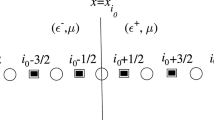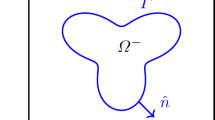Abstract
We study an finite-difference time-domain (FDTD) system of uniaxial perfectly matched layer (UPML) method for electromagnetic scattering problems. Particularly we analyze the discrete initial-boundary value problems of the transverse magnetic mode (TM) to Maxwell’s equations with Yee’s algorithm. An exterior domain in two spacial dimension is truncated by a square with a perfectly matched layer filled by a certain artificial medium. Besides, an artificial boundary condition is imposed on the outer boundary of the UPML. Using energy method, we obtain the stability of this FDTD system on the truncated domain. Numerical experiments are designed to approve the theoretical analysis.
Similar content being viewed by others
References
Taflov A. Computational Electrodynamics, The Finite Dependent Time Domain Approach (2nd ed). Norwood: Artech House, 2000
Lu Y H. Numerical Methods for Computational Electromagnetics (in Chinese). Beijing: Tsinghua University Press, 2006
Wang C Q. Computational Advanced Electromagnetics (in Chinese). Beijing: Peking University Press, 2005
Wang B Z. Computational Electromagnetics (in Chinese). Beijing: Science Press, 2002
Sheng X Q. Abstract of Computational Electromagnetics (in Chinese). Beijing: Science Press, 2004
Yee K S. Numerical solution of initial boundary value problems involving Maxwell’s equations. IEEE Trans Antennas Propag, 14: 302–307 (1966)
Ying L. Numerical Methods for Exterior Problems, Singapore: World Scientific, 2006
Bérenger J P. A perfectly matched layer for the absorption of electromagnetic waves. J Comput Phys, 114: 185–200 (1994)
Bérenger J P. Perfectly matched layer for the FDTD solution of wave-structure interaction problems. IEEE Trans Anttennas Propag, 44: 110–117 (1996)
Bérenger J P. Three dimensional perfectly matched layer for the absorption of electromagnetic waves. J Comput Phys, 127: 363–379 (1996)
Bérenger J P. Numerical reflection from FDTD-PMLs: a comparison of the split PML with the unsplit and CFS PMLs. IEEE Trans Anttennas Propag, 50(3): 258–265 (2002)
Abarbanel S A, Gottlieb D. A mathematical analysis of the PML method. J Comput Phys, 134: 357–363 (1997)
Chew W, Weedon W. A 3rd perfectly matched medium for modified Maxwell’s equations with streched coordinates. Microwave Opt Techno Lett, 13(7): 599–604 (1994)
Ying L. Analysis of the PML problems for time dependent Maxwell equations. Far East J Appl Math, 31(3): 299–320 (2008)
Becache E, Joly P. On the analysis of Berenger’s PML for Maxwell’s equations. Math Model Anal, 36(1): 87–120 (2002)
Fang N S, Ying L. Stability analysis of Yee schemes to PML and UPML for Maxwell equations. J Comput Math, to appear, 2009
Bramble J H, Pasciak J E. Analysis of a finite PML approximation for the three dimensional time-harmonic Maxwell and acoustic scattering problems. Math Comp, 76: 597–614 (2007)
Bao G, Wu H. Convergence analysis of the perfectly matched layer problems for time-harmonic Maxwell’s equations. SIAM J Numer Anal, 43(5): 2121–2143 (2005)
Chen Z, Liu X. An adaptive perfectly matched layers technique for time-harmonic scattering problems. SIAM J Numer Anal, 43: 645–671 (2005)
Chen Z, Wu H. An adaptive finite element method with perfectly matched absorbing layers for the wave scattering by periodic structures. SIAM J Numer Anal, 41: 799–826 (2003)
Lu T, Zhang P, Cai W. Discontinuous Galerkin methods for dispersive and lossy Maxwell’s equations and PML boundary conditions. J Comput Phys, 200(2): 549–580 (2004)
Kung F, Chuan H T. Stability of classicla FDTD formulation with nonlinear elements: a new perspective. J Electromagn Waves Appl, 17(9): 1313–1314 (2003)
Author information
Authors and Affiliations
Corresponding author
Rights and permissions
About this article
Cite this article
Fang, N., Ying, LA. Stability analysis of FDTD to UPML for time dependent Maxwell equations. Sci. China Ser. A-Math. 52, 794–816 (2009). https://doi.org/10.1007/s11425-009-0015-9
Received:
Accepted:
Published:
Issue Date:
DOI: https://doi.org/10.1007/s11425-009-0015-9




